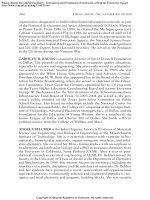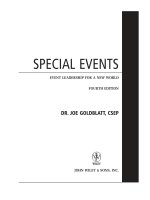Business communication developing leaders for a network world 2nd CHAPTER 6
Bạn đang xem bản rút gọn của tài liệu. Xem và tải ngay bản đầy đủ của tài liệu tại đây (1.3 MB, 46 trang )
Improving Readability
with Style and Design
Chapter 6
© 2016 by McGraw-Hill Education. This is proprietary material solely for authorized instructor use. Not authorized for sale or distribution in any manner. This document may not be copied, scanned, duplicated, forwarded, distributed, or posted on a website,
in whole or part.
Provide All Relevant Information
The key to providing all but only relevant information is to plan, write, and
review your message strategically
Repeatedly asking yourself what information is necessary for the purpose of
your message will help you accomplish this.
© 2016 by McGraw-Hill Education. This is proprietary material solely for authorized instructor use. Not authorized for sale or distribution in any manner. This document may not be copied, scanned, duplicated, forwarded, distributed, or posted on a website,
in whole or part.
6-2
Be Accurate
Accuracy, like specificity, strongly impacts your readers’ perceptions of your
credibility
Just one inaccurate statement can lead readers to dismiss your entire message
and lower their trust in your future communications as well.
© 2016 by McGraw-Hill Education. This is proprietary material solely for authorized instructor use. Not authorized for sale or distribution in any manner. This document may not be copied, scanned, duplicated, forwarded, distributed, or posted on a website,
in whole or part.
6-3
Being Accurate
© 2016 by McGraw-Hill Education. This is proprietary material solely for authorized instructor use. Not authorized for sale or distribution in any manner. This document may not be copied, scanned, duplicated, forwarded, distributed, or posted on a website,
in whole or part.
6-4
Be Specific
The more specific you are, the more likely your readers are to have their
questions answered
If you are not specific, your readers may become impatient and begin scanning
and skimming for the information they want
© 2016 by McGraw-Hill Education. This is proprietary material solely for authorized instructor use. Not authorized for sale or distribution in any manner. This document may not be copied, scanned, duplicated, forwarded, distributed, or posted on a website,
in whole or part.
6-5
Being Specific
© 2016 by McGraw-Hill Education. This is proprietary material solely for authorized instructor use. Not authorized for sale or distribution in any manner. This document may not be copied, scanned, duplicated, forwarded, distributed, or posted on a website,
in whole or part.
6-6
Improving Ease of Reading
with Conciseness
Control paragraph length
Use short sentences
Avoid empty phrases
Avoid redundancy
Avoid wordy
prepositional phrases
© 2016 by McGraw-Hill Education. This is proprietary material solely for authorized instructor use. Not authorized for sale or distribution in any manner. This document may not be copied, scanned, duplicated, forwarded, distributed, or posted on a
website, in whole or part.
6-7
Control Paragraph Length
Long paragraphs can signal disorganization and even disrespect for the reader’s
time
Typically, paragraphs should contain 40 to 80 words.
For routine messages, paragraphs as short as 20 to 30 words are common and
appropriate.
© 2016 by McGraw-Hill Education. This is proprietary material solely for authorized instructor use. Not authorized for sale or distribution in any manner. This document may not be copied, scanned, duplicated, forwarded, distributed, or posted on a website,
in whole or part.
6-8
Controlling Paragraph Length
© 2016 by McGraw-Hill Education. This is proprietary material solely for authorized instructor use. Not authorized for sale or distribution in any manner. This document may not be copied, scanned, duplicated, forwarded, distributed, or posted on a website,
in whole or part.
6-9
Use Short Sentences in Most Cases
Short sentences allow your readers to comprehend your ideas more easily
For routine messages, aim for average sentence length of 15 or fewer words
© 2016 by McGraw-Hill Education. This is proprietary material solely for authorized instructor use. Not authorized for sale or distribution in any manner. This document may not be copied, scanned, duplicated, forwarded, distributed, or posted on a website,
in whole or part.
6-10
Using Short Sentences
© 2016 by McGraw-Hill Education. This is proprietary material solely for authorized instructor use. Not authorized for sale or distribution in any manner. This document may not be copied, scanned, duplicated, forwarded, distributed, or posted on a website,
in whole or part.
6-11
Avoiding Redundancy
© 2016 by McGraw-Hill Education. This is proprietary material solely for authorized instructor use. Not authorized for sale or distribution in any manner. This document may not be copied, scanned, duplicated, forwarded, distributed, or posted on a website,
in whole or part.
6-12
Avoiding Empty Phrases
© 2016 by McGraw-Hill Education. This is proprietary material solely for authorized instructor use. Not authorized for sale or distribution in any manner. This document may not be copied, scanned, duplicated, forwarded, distributed, or posted on a website,
in whole or part.
6-13
Avoid Wordy Prepositional Phrases
Eliminating extra words allows you to get your ideas across as efficiently as
possible.
You will often find that you can reduce word count by 30 to 40 percent simply by
converting many of your prepositional phrases into single-word verbs.
© 2016 by McGraw-Hill Education. This is proprietary material solely for authorized instructor use. Not authorized for sale or distribution in any manner. This document may not be copied, scanned, duplicated, forwarded, distributed, or posted on a website,
in whole or part.
6-14
Avoiding Wordy
Prepositional Phrases
© 2016 by McGraw-Hill Education. This is proprietary material solely for authorized instructor use. Not authorized for sale or distribution in any manner. This document may not be copied, scanned, duplicated, forwarded, distributed, or posted on a website,
in whole or part.
6-15
Improving Ease of Reading with Natural Style
© 2016 by McGraw-Hill Education. This is proprietary material solely for authorized instructor use. Not authorized for sale or distribution in any manner. This document may not be copied, scanned, duplicated, forwarded, distributed, or posted on a
website, in whole or part.
6-16
Use Action Verbs When Possible
First, find nouns that you can convert to action verbs
Second, find forms of the verb to be (e.g., verbs such as is , are , am ) and convert
them into action verbs
© 2016 by McGraw-Hill Education. This is proprietary material solely for authorized instructor use. Not authorized for sale or distribution in any manner. This document may not be copied, scanned, duplicated, forwarded, distributed, or posted on a website,
in whole or part.
6-17
Using Action Verbs
© 2016 by McGraw-Hill Education. This is proprietary material solely for authorized instructor use. Not authorized for sale or distribution in any manner. This document may not be copied, scanned, duplicated, forwarded, distributed, or posted on a website,
in whole or part.
6-18
Use Active Voice
© 2016 by McGraw-Hill Education. This is proprietary material solely for authorized instructor use. Not authorized for sale or distribution in any manner. This document may not be copied, scanned, duplicated, forwarded, distributed, or posted on a website,
in whole or part.
6-19
Use Active Voice
The doer-action-object allows for faster processing because most people’s
natural thinking occurs in this way
It also emphasizes the business orientation of action
Most important, it specifies the doer
© 2016 by McGraw-Hill Education. This is proprietary material solely for authorized instructor use. Not authorized for sale or distribution in any manner. This document may not be copied, scanned, duplicated, forwarded, distributed, or posted on a website,
in whole or part.
6-20
Using Active Voice Appropriately
© 2016 by McGraw-Hill Education. This is proprietary material solely for authorized instructor use. Not authorized for sale or distribution in any manner. This document may not be copied, scanned, duplicated, forwarded, distributed, or posted on a website,
in whole or part.
6-21
Using Passive Voice Appropriately
© 2016 by McGraw-Hill Education. This is proprietary material solely for authorized instructor use. Not authorized for sale or distribution in any manner. This document may not be copied, scanned, duplicated, forwarded, distributed, or posted on a website,
in whole or part.
6-22
Use Short and Familiar
Words and Phrases
Whenever possible, choose short, conversational, and familiar words
Using longer, less common ones slows processing and can distract from your
message.
© 2016 by McGraw-Hill Education. This is proprietary material solely for authorized instructor use. Not authorized for sale or distribution in any manner. This document may not be copied, scanned, duplicated, forwarded, distributed, or posted on a website,
in whole or part.
6-23
Use Parallel Language
Using parallel language means that you apply a consistent grammatical pattern
across a sentence or paragraph.
Parallelism is most important when you use series or lists.
© 2016 by McGraw-Hill Education. This is proprietary material solely for authorized instructor use. Not authorized for sale or distribution in any manner. This document may not be copied, scanned, duplicated, forwarded, distributed, or posted on a website,
in whole or part.
6-24
Using Parallel Language
© 2016 by McGraw-Hill Education. This is proprietary material solely for authorized instructor use. Not authorized for sale or distribution in any manner. This document may not be copied, scanned, duplicated, forwarded, distributed, or posted on a website,
in whole or part.
6-25









